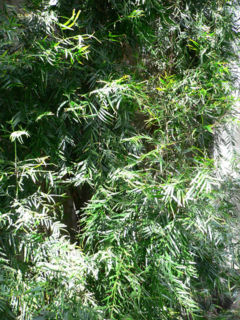Afrocarpus
| Afrocarpus subsp. var. | ||||||||||||||||||||||||||||||||||||||||||||||||||||||||
|---|---|---|---|---|---|---|---|---|---|---|---|---|---|---|---|---|---|---|---|---|---|---|---|---|---|---|---|---|---|---|---|---|---|---|---|---|---|---|---|---|---|---|---|---|---|---|---|---|---|---|---|---|---|---|---|---|

|
|
| ||||||||||||||||||||||||||||||||||||||||||||||||||||||
| ||||||||||||||||||||||||||||||||||||||||||||||||||||||||
| Afrocarpus {{{status}}} Fossil range: {{{fossil_range}}}
| ||||||||||||||||||||||||||||||||||||||||||||||||||||||||||||||||||
|---|---|---|---|---|---|---|---|---|---|---|---|---|---|---|---|---|---|---|---|---|---|---|---|---|---|---|---|---|---|---|---|---|---|---|---|---|---|---|---|---|---|---|---|---|---|---|---|---|---|---|---|---|---|---|---|---|---|---|---|---|---|---|---|---|---|---|
 Afrocarpus gracilior | ||||||||||||||||||||||||||||||||||||||||||||||||||||||||||||||||||
| Plant Info | ||||||||||||||||||||||||||||||||||||||||||||||||||||||||||||||||||
| ||||||||||||||||||||||||||||||||||||||||||||||||||||||||||||||||||
| Scientific classification | ||||||||||||||||||||||||||||||||||||||||||||||||||||||||||||||||||
| ||||||||||||||||||||||||||||||||||||||||||||||||||||||||||||||||||
| [[{{{diversity_link}}}|Diversity]] | ||||||||||||||||||||||||||||||||||||||||||||||||||||||||||||||||||
| {{{diversity}}} | ||||||||||||||||||||||||||||||||||||||||||||||||||||||||||||||||||
| Binomial name | ||||||||||||||||||||||||||||||||||||||||||||||||||||||||||||||||||
| {{{binomial}}} | ||||||||||||||||||||||||||||||||||||||||||||||||||||||||||||||||||
| Trinomial name | ||||||||||||||||||||||||||||||||||||||||||||||||||||||||||||||||||
| {{{trinomial}}} | ||||||||||||||||||||||||||||||||||||||||||||||||||||||||||||||||||
| Type Species | ||||||||||||||||||||||||||||||||||||||||||||||||||||||||||||||||||
| {{{type_species}}} | ||||||||||||||||||||||||||||||||||||||||||||||||||||||||||||||||||
| Species | ||||||||||||||||||||||||||||||||||||||||||||||||||||||||||||||||||
| Afrocarpus dawei Afrocarpus falcatus | ||||||||||||||||||||||||||||||||||||||||||||||||||||||||||||||||||
| [[Image:{{{range_map}}}|{{{range_map_width}}}|]] | ||||||||||||||||||||||||||||||||||||||||||||||||||||||||||||||||||
| Synonyms | ||||||||||||||||||||||||||||||||||||||||||||||||||||||||||||||||||
| {{{synonyms}}} |
Afrocarpus is a genus of conifers belonging to the podocarp family Podocarpaceae. Afrocarpus was designated a genus in 1989, when several species formerly classified in Podocarpus and Nageia were reclassified. Six species are recognized.
As the name intimates, Afrocarpus is native to Africa. The species are distributed through the Afromontane forests of eastern and southern Africa, descending to the Indian Ocean coast in South Africa. A. gaussenii is native of Madagascar.
The podocarps are associated with the ancient supercontinent of Gondwana, where they were characteristic of the cool, moist southern Gondwana flora. Gondwana broke up into the continents of South America, Africa, India, Australia and Antarctica between 160 and 30 million years ago. As Africa drifted north it became hotter and drier, and the podocarps generally retreated to the cool moist highlands of eastern and southern Africa.
In South Africa, this wood is mostly used to make exclusive furniture.
- Afrocarpus dawei is native to the highlands of east Africa, including Kenya, Tanzania, Uganda, and Congo.
- Afrocarpus falcatus, commonly known as the Outeniqua yellowwood, is a tall tree, generally 10-25 m high, but growing up to 60 m. It is native to montane forests of South Africa, from Swellendam District of Western Cape Province to Limpopo Province, and into southern Mozambique.
- Afrocarpus gaussenii, native to the eastern plateau of Madagascar.
- Afrocarpus gracilior, native to Ethiopia, Kenya, Tanzania, and Uganda. Used in gardens as a tree, hedge, screen, or espalier; generally sold as Podocarpus gracilior.
- Afrocarpus mannii, native to São Tomé Island in the Gulf of Guinea.
- Afrocarpus usambarensis, native to Burundi, Rwanda, Congo, and Lushoto and Mbulu districts of Tanzania.
References
Page, C. N. 1989. New and maintained genera in the conifer families Podocarpaceae and Pinaceae. Notes of the Royal Botanical Garden Edinburgh 45(2): 377-395.